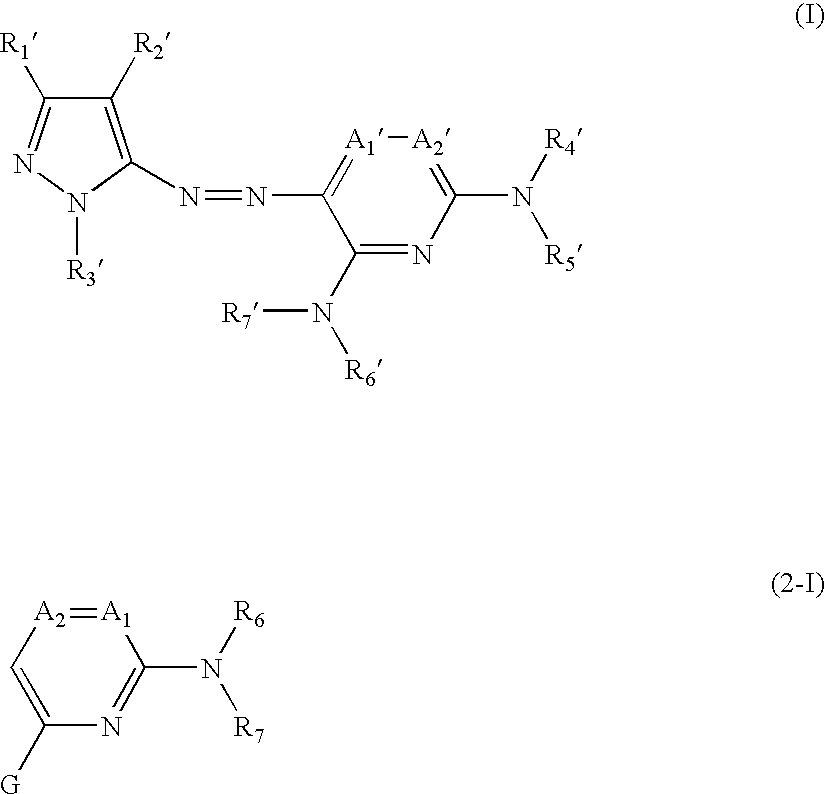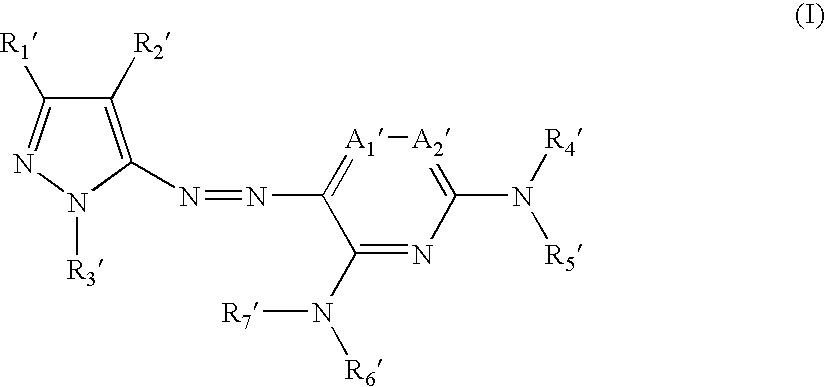Azo compound and process of producing the same, and novel compound and process of producing azo compounds using the same
a technology which is applied in the field of azo compound and process of producing the same, and novel compound and process of producing azo compound using the same, can solve the problems of insufficient absorption characteristics, difficult to obtain colorants meeting all these requirements, and insufficient light fastness, etc., to achieve satisfactory color reproduction, excellent absorption characteristics, and sufficient fastness
- Summary
- Abstract
- Description
- Claims
- Application Information
AI Technical Summary
Benefits of technology
Problems solved by technology
Method used
Image
Examples
examples
[0188] The present invention will now be illustrated in greater detail with reference to Synthesis Examples and Examples, but it should be understood that the invention is not deemed to be limited thereto. Unless otherwise noted, all the percents and parts are by weight.
Synthesis Example b 1
Synthesis of Compound 1-1
[0189] 1) Synthesis of Compound 1-1a
[0190] A mixture of 8 g (48.7 mmol) of 5-amino-3-t-butyl-4-cyanopyrazole (1), 15 ml of concentrated hydrochloric acid, and 50 ml of water was stirred at an inner temperature of 5° C., and 3.36 g (48.7 mmol) of sodium nitrite was added thereto in divided portions over 10 minutes. After the addition, the stirring was continued for 10 minutes to form a diazonium salt.
[0191] Separately, 21.3 g (40.6 mmol) of coupling component (2) was put in a three-necked flask, and 50 g of sodium acetate, 50 ml of dimethylformamide (DMF), and 50 ml of ethyl acetate were added thereto. The mixture was stirred and cooled to an inner temperature of 5° ...
synthesis example 2
[0196] Synthesis of Compound 2-1
1) Synthesis of Compound 2-1a
[0197] A mixture of 8 g (48.7 mmol) of 5-amino-3-t-butyl-4-cyanopyrazole (1), 15 ml of concentrated hydrochloric acid, 8 ml of acetic acid, and 12 ml of propionic acid was stirred at an inner temperature of 5° C., and a solution of 3.36 g (48.7 mmol) of sodium nitrite in 10 ml of water was added thereto dropwise over 10 minutes. After the dropwise addition, the stirring was continued for 30 minutes to form a diazonium salt. Separately, 100 ml of pyridine was added to 18.5 g (40.6 mmol) of coupling component (2), and the mixture was stirred and cooled to an inner temperature of 5° C. The diazonium salt was put into the mixture over 30 minutes, and the stirring was continued for an additional 30 minute period. Three hundred milliliters of a saturated aqueous solution of sodium chloride was added to the reaction mixture. The precipitate was collected by filtration by suction to isolate compound (4-5) in a yield of 17.6 g ...
synthesis example 3
[0202] Synthesis of Compound 2-1
[0203] To 37.3 g (56 mmol) of compound 2-4 were added 18.9 g (112 mmol) of 2-chlorobenzothiazole (heterylating agent 3), 20 g of potassium carbonate, and 210 ml of dimethyl sulfoxide (DMSO), and the mixture was heated at 100° C. for 4 hours with stirring while bubbling with nitrogen. After completion of the reaction, the reaction mixture was cooled to room temperature. The precipitate thus formed was collected by suction filtration, and the resulting crystals were washed with 200 ml of DMSO. The crystals were dispersed in 1500 ml of water, filtered by suction, and washed with water to give 29 g (65%) of compound 2-1. [0204]λmax=558 nm (DMF solution) [0205] m / z (positive ion mode)=802
PUM
| Property | Measurement | Unit |
|---|---|---|
| temperature | aaaaa | aaaaa |
| temperature | aaaaa | aaaaa |
| pH | aaaaa | aaaaa |
Abstract
Description
Claims
Application Information
 Login to View More
Login to View More - R&D
- Intellectual Property
- Life Sciences
- Materials
- Tech Scout
- Unparalleled Data Quality
- Higher Quality Content
- 60% Fewer Hallucinations
Browse by: Latest US Patents, China's latest patents, Technical Efficacy Thesaurus, Application Domain, Technology Topic, Popular Technical Reports.
© 2025 PatSnap. All rights reserved.Legal|Privacy policy|Modern Slavery Act Transparency Statement|Sitemap|About US| Contact US: help@patsnap.com



